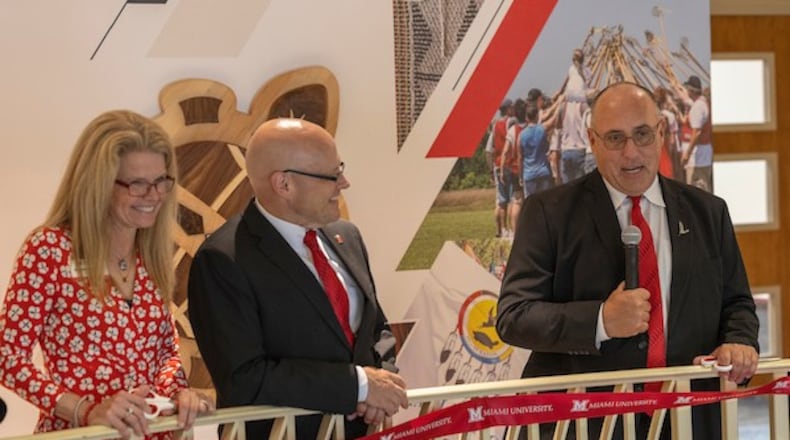“The love and honor this university shows to our people is just unbelievable,” Chief Lankford said before joining other Tribe leaders, Crawford and his wife and university ambassador, Renate Crawford, in cutting the ribbon outside the second-floor classroom.
Crawford called the classroom at the top of the stairs, also known as the Great Room, “another piece of this history we share with the Tribe. We are one; we are together,” according to a statement from school officials.
The transformed classroom space includes several Myaamia words or phrases and their English translations on the walls.
These include kiiloona myaamiaki, which means “We are Miami,” myaamionki, which means “Myaamia homelands,” and tapaalintioni nahiteehioni, which means “Love and Honor.”
Other new features of the remodeled classroom include lighting in the raised ceiling that can feature multiple colors, including shades of red to resemble light illuminating from a burning fire.
Fire, as captured in the Myaamia Heritage Logo, is symbolic of the warmth of the partnership and recognition of the shared responsibility needed to “tend the fire” to continue nurturing the relationship.
Over time, the relationship has grown stronger, with steps that have included Miami’s Land Acknowledgement saying Miami is located within the traditional homelands of the Myaamia and Shawnee people, said school officials.
The Miami people were forcibly removed from their homelands in 1846. The university was founded in 1809 and enrolled its first students in 1824.
The relationship led to the creation of the Myaamia Center at Miami University in 2001. The Tribe’s research arm is dedicated to the revitalization of Miami language and culture and to restoring that knowledge to the Myaamia people.
“People ask me all the time, why does it work so well at Miami?” Crawford told those who gathered for the May 3 classroom ribbon cutting. “I think it really boils down to one word: neepwaantiinki. That word means ‘learning from each other,’ and I think that’s what makes this relationship so special.”
Chief Lankford said, “As a nation, we can’t say enough about this university and the people who are here. Our language would not be where it is. Our culture would not be where it is. None of these things — they might exist — but nothing like what we have today without the help and support of this university.”
About the Author

